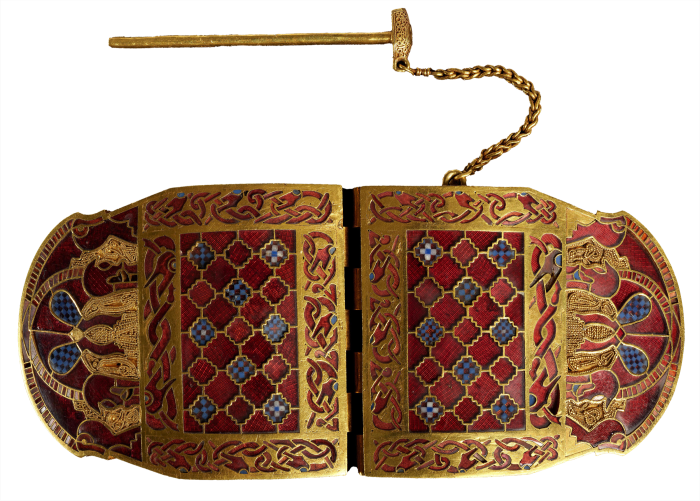Jewellers carry on the Silk Road’s precious stone traditions

Unlock the Editor’s Digest for free
Roula Khalaf, Editor of the FT, selects her favourite stories in this weekly newsletter.
Treasures found inside the Sutton Hoo Anglo-Saxon ship burial — on its discovery in Suffolk, eastern England, in 1939 — included some of the best-surviving examples of garnet cloissoné metalwork. Now, scientific analysis has revealed the origin of these stones.
Research conducted for the British Museum’s Silk Roads exhibition, which opened last week, found that all but one of five pieces analysed comprise different hued stones from present-day Czechia, India and Sri Lanka. However, the particle-induced X-ray emission analysis of a gold and garnet imitation buckle from a sword-scabbard (early 600s) found those garnets all came from Rajasthan, India.
“One of the possible interpretations of that is that they specifically selected this particular type of garnet to make that one piece of jewellery because it was much higher quality than anything else,” says Sue Brunning, the museum’s curator of European Early Medieval and Sutton Hoo collections. “The question is: did they select these garnets simply because they were better quality or did they know that they had come from a particular place, which added an extra prestige?” Garnets were a “badge of elite status” at that time.
The Sutton Hoo imitation buckle and a gold, glass and garnet shoulder-clasp (c. late 500s-early 600s) are among more than 300 objects dating from about AD500-1000 being displayed to help challenge the idea that the “Silk Road” between east and west emerged only in the 19th century. Rather than being a single trade route, the exhibition suggests the Silk Roads comprised overlapping networks spreading from Japan to Britain, and Scandinavia to Madagascar. “It’s not just silk, it’s not just one road,” says Brunning. “It’s people, objects and ideas moving in all directions.” The garnets would have travelled to England “in stages by relay”.

Jewellers have been inspired by this historic trade network for contemporary designs. “[The Silk Road] is part of our history so . . . it’s something we are very happy and excited to continue to build on,” says Roberto Boghossian, managing partner of Boghossian, the sixth generation of the family involved in the Geneva-based jewellery house. “We believe it really represents who we are and what we stand for. We’re the perfect example of a cultural blend, coming from the east and settled in the west.”
His ancestor, Ovaness Boghossian, set up a jewellery workshop in the Turkish city of Mardin in 1868, with the family expanding into buying and selling stones before eventually settling in Europe in the 1970s. Today, Roberto Boghossian says the brand’s designs are inspired by “the femininity, the warmth [and] the colours of the east. And we blend it with the newness and the technicality and the invention from the west”.

Pieces from the recent Palace Voyages high jewellery collection, which draws on the architectural and decorative details of 14 palaces from China to the UK, are being shown at the PAD London art and design fair next week. Roberto Boghossian says this “eclectic but meaningful collection” represents his family’s travels.
Chinese high jewellery artist Anna Hu first took inspiration from the trade route for her five-piece Silk Road Music Collection, auctioned by Sotheby’s in 2019. A proportion of the proceeds was donated to Silkroad, a not-for-profit music organisation founded by cellist Yo-Yo Ma that was similarly inspired by the cultural collaboration in early trade. Hu’s Dunhuang Pipa necklace with a 100.02-carat fancy intense yellow diamond, named after the Chinese four-stringed musical instrument, sold for HK$45.4mn ($5.8mn).
Hu, herself a trained cellist, has continued to draw on the music and dance of the Silk Road. Her Dance of Dunhuang brooch, unveiled at TEFAF Maastricht in March, was inspired by the silhouette of flying apsaras: figures depicted in cave murals in the Chinese city. The titanium piece, featuring pearls, white, yellow and pink diamonds, and pink and orange sapphires, is shaped like a tulip, a flower she understands was traded on the Silk Road.

Hu considers music and colour “like a duet”. “When I look at a colour, I think of a certain tonality,” she says. “A C major is a golden light of yellow or white, and then D flat major is this really pastel lavender.”
Her Enchanted White Lily Bangle, acquired by the British Museum this year, shows her signature blending of east and west, in this case mixing ancient Chinese tradition with modern European craftsmanship and technology. She likes to reflect her life as a “global citizen”: born and raised in Taiwan, she has spent half her life in the US and Europe.
Jewellery in the Silk Roads exhibition showing the movement of materials across geographic regions includes a string of blue beads (500s) excavated in Japan that comprises glass from both Iran and elsewhere in Asia. A gold Byzantine necklace and earrings (c500-600) from Asyut, Egypt, features Arabian pearl, as well as sapphire and emerald.
While the exhibition demonstrates that trade was broader than silk, that material has inspired jewellers, too. In the 2018 Silk collection, Boghossian translated traditional silk weaving into pieces featuring gemstones representing key cities along the Silk Road. And seeing the traditional craft in Uzbekistan’s Fergana Valley led to Silvia Furmanovich’s 2022 Silk Road collection.
“In the Silk Road, there’s this really rich exchange of commodities, ideas and materials and I love that cultural exchange,” says the Brazilian jeweller, who recently visited Kashmir, another part of the trade network, to research an upcoming collection.
#Jewellers #carry #Silk #Roads #precious #stone #traditions






